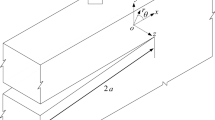Abstract
Configurational forces invariably appear at the external boundaries of cracked bodies (including the crack faces), but it is unclear whether they influence crack growth. Also, it is unclear how such boundary configurational forces are related to the J-integrals calculated in the body. In this brief note, we (i) derive expressions for the surface configurational forces and determine their values on regions of the external boundaries with prescribed tractions or displacements, (ii) determine the relation between the far-field J-integral and the surface configurational forces, and (iii) show that surface configurational forces on the crack faces do not alter the relation between the near-tip and far-field J-integrals.
Similar content being viewed by others
References
Anderson TL (2004) Fracture mechanics: fundamentals and applications, 3rd edn. CRC Press, Boca Raton
Fischer FD, Predan J, Kolednik O, Simha NK (2007) Application of material forces to fracture of inhomogeneous materials: illustrative examples. Arch Appl Mech 77:95–112. Erratum (2008) 78:835
Gross D, Seelig T (2006) Fracture mechanics, with an introduction to micromechanics. Springer, Berlin
Gurtin ME, Podio-Guidugli P (1996) Configurational forces and the basic laws for crack propagation. J Mech Phys Solids 44: 905–927
Gurtin ME (2000) Configurational forces as basic concepts of continuum physics. Springer, Berlin
Hutchinson JW (1968) Singular behavior at the end of a tensile crack tip in a hardening material. J Mech Phys Solids 16: 13–31
Irschik H (2007) On rational treatments of the general laws of balance and jump, with emphasis on configurational formulations. Acta Mech 194: 11–32
Kienzler R, Herrmann G (2000) Mechanics in material space. Springer, Berlin
Kienzler R, Rohde L, Schröder R, Kutz K (2009) Treating mixed-mode problems with path-independent integrals. In: Elboujdaini M et al. (eds) Proc 12th International Conference on Fracture (ICF12), paper T06.029, 10 p
Kolednik O, Predan J, Fischer FD (2010) Reprint of cracks in inhomogeneous materials: comprehensive assessment using the configurational forces concept. Eng Fract Mech 77: 3611–3624
Maugin GA (1993) Material inhomogeneities in elasticity. Chapman & Hall, London
Maugin GA (1995) Material forces: concepts and applications. ASME Appl Mech Rev 48: 213–245
Maugin GA (2010) Configurational forces: thermomechanics, physics, mathematics, and numerics. CRC Press, Boca Raton
Mueller R, Kolling S, Gross D (2002) On configurational forces in the context of the finite element method. Int J Numer Meth Eng 53: 1557–1574
Mueller R, Gross D, Maugin GA (2004) Use of material forces in adaptive finite element methods. Comput Mech 33: 421–434
Parks DM (1977) The virtual crack extension method for nonlinear material behavior. Comput Meth Appl Mech Eng 12: 353–364
Rice JR (1968) A path independent integral and the approximate analysis of strain concentration by notches and cracks. ASME J Appl Mech 35: 379–386
Rice JR, Rosengren GF (1968) Plane strain deformation near a crack tip in a power-law hardening material. J Mech Phys Solids 16: 1–12
Schöngrundner R, Kolednik O, Fischer FD (2010) The configurational force concept in elastic-plastic fracture mechanics—instructive examples. Key Eng Mater 417-418: 297–300
Shan GX (2008) Post-processing program for calculating the configurational forces with ABAQUS, internal report, K2 Competence Center “Integrated research in materials, processing and product engineering”, Leoben, Austria
Simha NK, Bhattacharya K (1998) Kinetics of a phase boundary with edges and junctions. J Mech Phys Solids 46: 2323–2359
Simha NK, Fischer FD, Kolednik O, Chen CR (2003) Inhomogeneity effects on the crack driving force in elastic and elastic-plastic materials. J Mech Phys Solids 51: 209–240
Simha NK, Predan J, Kolednik O, Fischer FD, Shan GX (2005) Crack tip shielding or anti-shielding due to smooth and discontinuous material inhomogeneities. Int J Fract 135: 73–93
Simha NK, Fischer FD, Shan GX, Chen CR, Kolednik O (2008) J-integral and crack driving force in elastic-plastic materials. J Mech Phys Solids 56: 2876–2895
Steinmann P (2000) Application of material forces to hyperelastostatic fracture mechanics part I: continuum mechanical setting. Int J Solids Struct 37: 7371–7391
Williams ML (1957) On the stress distribution at the base of a stationary crack. ASME J Appl Mech 24: 109–114
Author information
Authors and Affiliations
Corresponding author
Rights and permissions
About this article
Cite this article
Fischer, F.D., Simha, N.K., Predan, J. et al. On configurational forces at boundaries in fracture mechanics. Int J Fract 174, 61–74 (2012). https://doi.org/10.1007/s10704-011-9672-0
Received:
Accepted:
Published:
Issue Date:
DOI: https://doi.org/10.1007/s10704-011-9672-0




